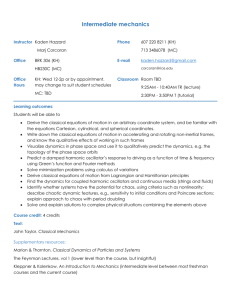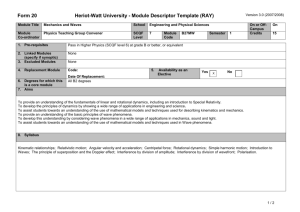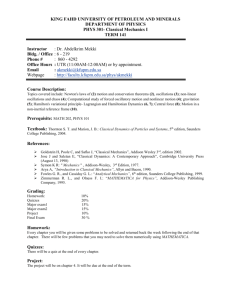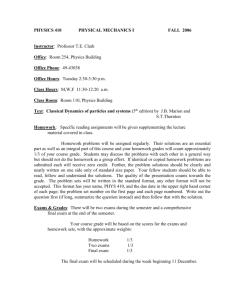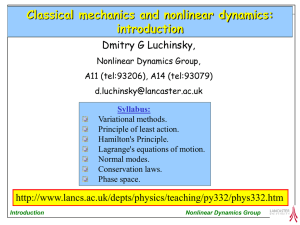PHYS 515 “CLASSICAL DYNAMICS” Fall 2015 Syllabus
advertisement
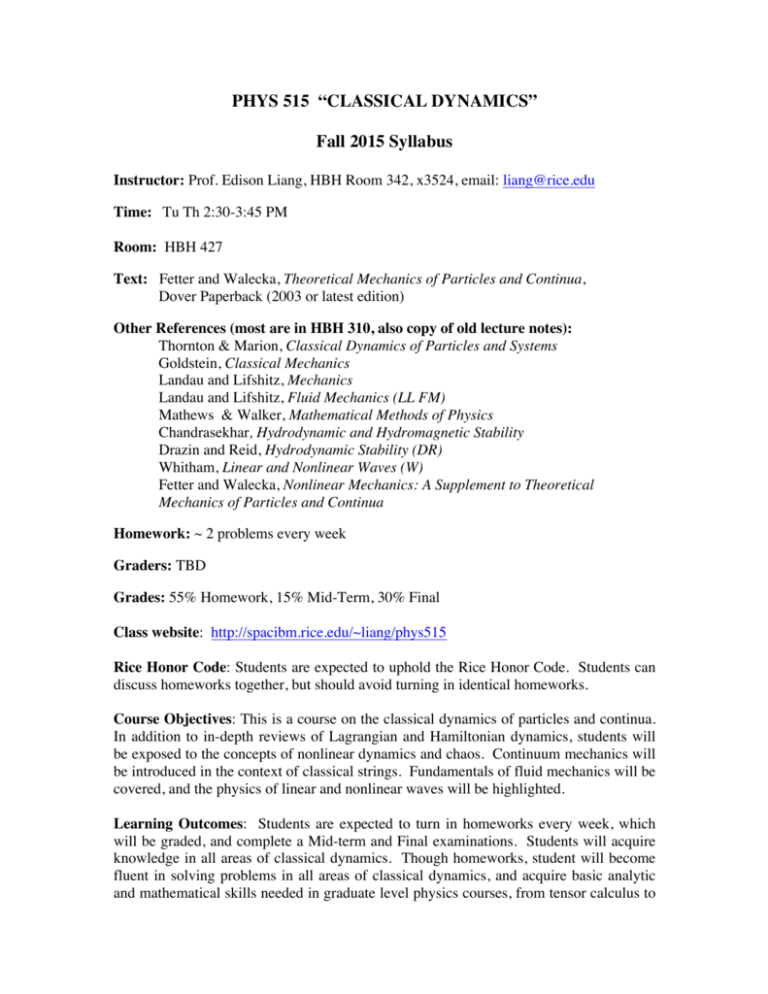
PHYS 515 “CLASSICAL DYNAMICS” Fall 2015 Syllabus Instructor: Prof. Edison Liang, HBH Room 342, x3524, email: liang@rice.edu Time: Tu Th 2:30-3:45 PM Room: HBH 427 Text: Fetter and Walecka, Theoretical Mechanics of Particles and Continua, Dover Paperback (2003 or latest edition) Other References (most are in HBH 310, also copy of old lecture notes): Thornton & Marion, Classical Dynamics of Particles and Systems Goldstein, Classical Mechanics Landau and Lifshitz, Mechanics Landau and Lifshitz, Fluid Mechanics (LL FM) Mathews & Walker, Mathematical Methods of Physics Chandrasekhar, Hydrodynamic and Hydromagnetic Stability Drazin and Reid, Hydrodynamic Stability (DR) Whitham, Linear and Nonlinear Waves (W) Fetter and Walecka, Nonlinear Mechanics: A Supplement to Theoretical Mechanics of Particles and Continua Homework: ~ 2 problems every week Graders: TBD Grades: 55% Homework, 15% Mid-Term, 30% Final Class website: http://spacibm.rice.edu/~liang/phys515 Rice Honor Code: Students are expected to uphold the Rice Honor Code. Students can discuss homeworks together, but should avoid turning in identical homeworks. Course Objectives: This is a course on the classical dynamics of particles and continua. In addition to in-depth reviews of Lagrangian and Hamiltonian dynamics, students will be exposed to the concepts of nonlinear dynamics and chaos. Continuum mechanics will be introduced in the context of classical strings. Fundamentals of fluid mechanics will be covered, and the physics of linear and nonlinear waves will be highlighted. Learning Outcomes: Students are expected to turn in homeworks every week, which will be graded, and complete a Mid-term and Final examinations. Students will acquire knowledge in all areas of classical dynamics. Though homeworks, student will become fluent in solving problems in all areas of classical dynamics, and acquire basic analytic and mathematical skills needed in graduate level physics courses, from tensor calculus to linear algebra and partial differential equations. The examinations will consist of both conceptual questions and computational problems, to test the student’s ability to think and compute. Any student with a documented disability that requires accommodation should contact both the course instructor and Disability Support Services in the Allen Center. PHYS 515 “CLASSICAL DYNAMICS” Tentative No. of Lectures 3 3 1 2 2 3 2 2 4 2 Topics Laws of Motion and Conservation Laws, Inertial Frames, Noninertial and Rotating Frames, Galilean Transformation, Generalized Transformations, Tensor Notations Variational Principle and Lagrangian Dynamics: Constraints and Lagrange Multipliers, Hamiltonian, Symmetry and Constants of Motion, Similarity Brief Review of Central Forces, Kepler’s Problem, Scattering Small Oscillations: Normal Modes and Eigenvalue Problems, Driven Oscillations and Resonance, Dissipation, Anharmonic Oscillations Brief Review of Rigid Body Motions: Euler Angles, Euler Equations of Motion Hamiltonian Dynamics: Canonical Transformations, Action-Angle Variable, Hamilton-Jacobi Theory; Poisson Brackets, Transition to Quantum Mechanics, Symmetry Principles and Contact Transformations, Liouville’s Theorem, adiabatic invariant Nonlinear Dynamics and Chaos Strings: Waves, Green Function, Perturbation Theory, Boundary Value Problems Introduction to Fluid Mechanics, Euler & Navier-Stokes Equations, Sound Waves, Shock Waves Surface Waves, Solitary Wave, bores Text Chapter # 1, 2 3 1 4 5 6 Supplement 7, 8 9 10, W 2 Hydrodynamic Instabilities DR, LL FM 2 2-D flows, Self-Similar Solutions, Turbulence LL FM PHYS 515 “CLASSICAL DYNAMICS” Sample mathematics topics covered in this course: 1. Non-Cartesian coordinates, vector and tensor calculus, index notations. 2. Complex variables including contour integration. 3. Delta-function and distributions. 4. Ordinary differential equations: eigenfunction expansions and boundary value problems. 5. Matrices, eigenvectors and eigenvalues. 6. Linear partial differential equations and Green function techniques. 7. Variational methods. 8. Perturbation theory. 9. Nonlinear partial differential equations.
